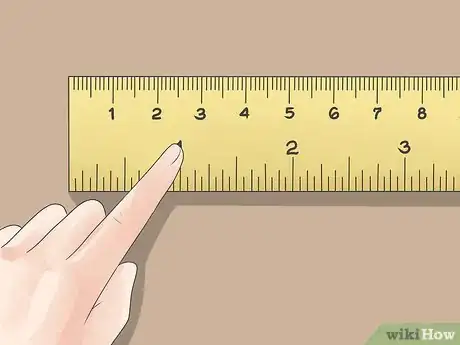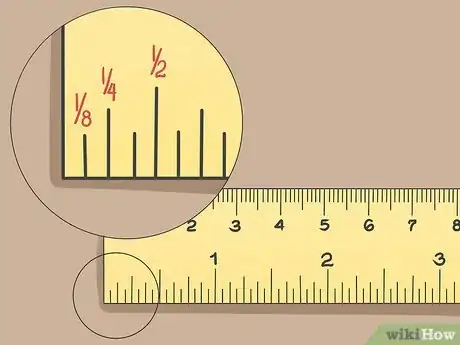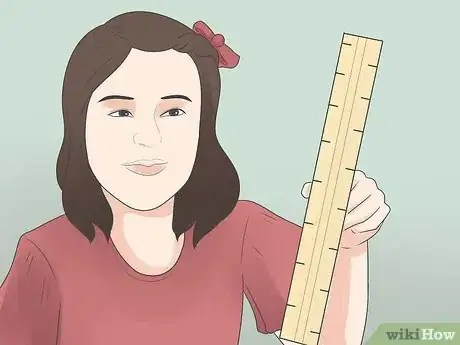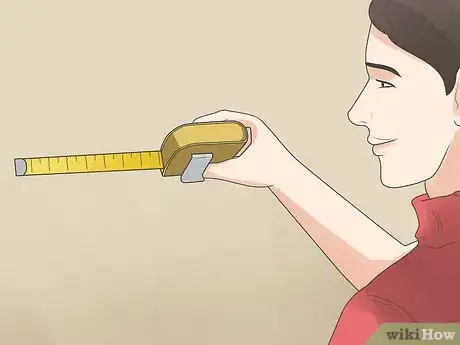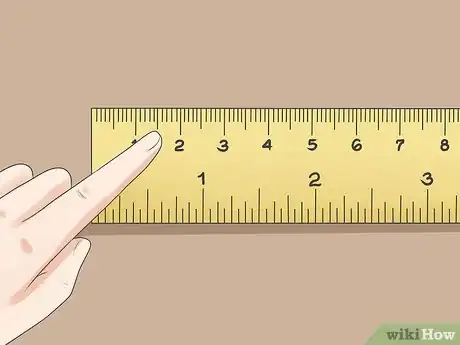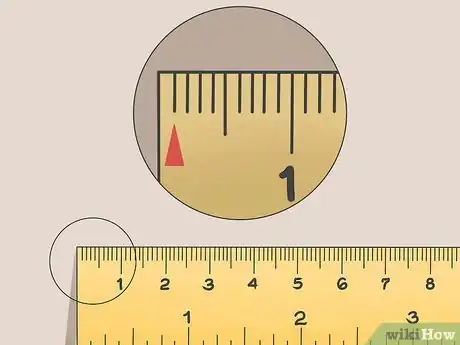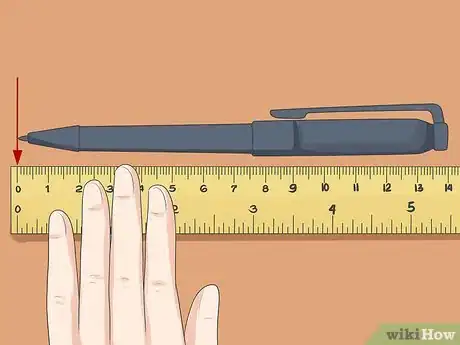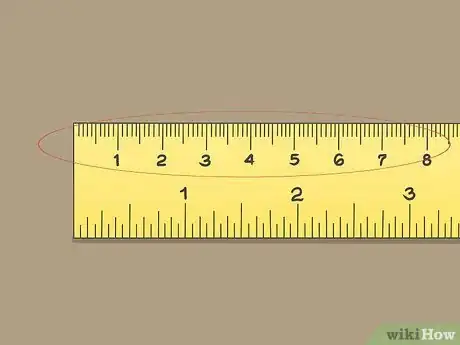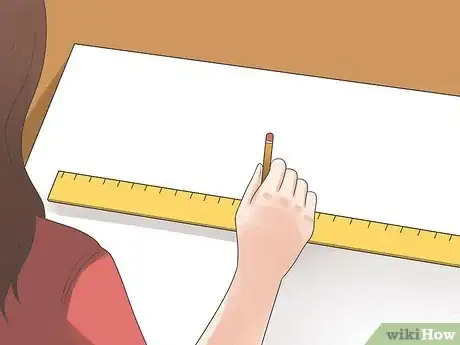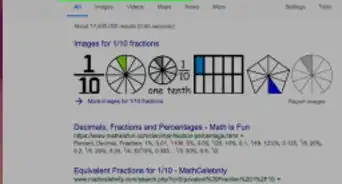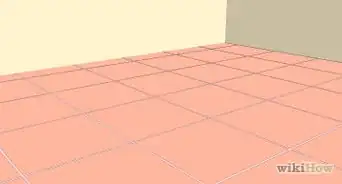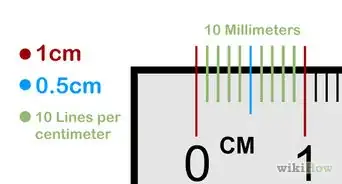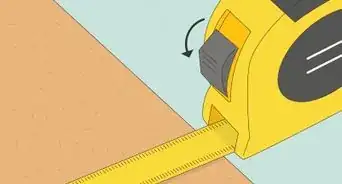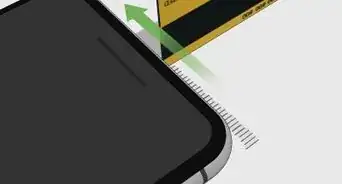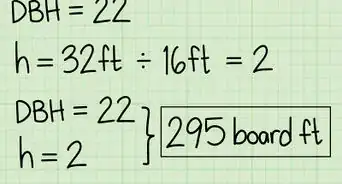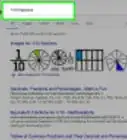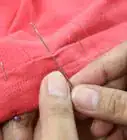This article was co-authored by Jessie Antonellis-John. Jessie Antonellis-John is a Math and Science Instructor who teaches at Southwestern Oregon Community College. With over 10 years of experience, she specializes in curriculum development. Jessie earned her PhD in Teaching & Teacher Education from the University of Arizona, her Master of Education from Western Governors University, and her BS in Astrophysics from Mount Holyoke College. She’s also co-authored several peer-reviewed journal articles in professional publications.
This article has been viewed 539,306 times.
A ruler is one of the most common measuring instruments. The ruler, shows both imperial and metric measurements. One side is 12 "inches" long (imperial), while the other is 30 centimeters (metric). The yardstick (3 feet long) or meter stick (100 cm or 1000 mm long) are two longer rulers. These longer units of measure can be made of hard material, while a measuring tape is yet another type of ruler made of flexible cloth or metal tape. Each may look different, but are used essentially the same way. Rulers and other measuring tapes might come in both standard and metric units. It is important to know the difference between these two systems of measurement units. This article addresses types of rulers and similar measuring tools, how to read a ruler, and using a ruler.
Steps
Reading a Standard Unit Ruler
-
1Learn how U.S. Customary units work. U.S. Customary units, sometimes called "Standard Units" in the U.S, are based on feet and inches. [1]
- The inch is the basic unit in U.S. standard measurement.
- There are 12 inches in a foot.
- Most rulers are 12 inches long.
- Longer rulers, which are 3 feet long (or 36 inches long, equal to one yard) are called yardsticks.
- Most countries don't use this unit of measurement any longer, preferring the metric system.
-
2Find the inches unit on your ruler. These are larger lines next to large numbers on your ruler. [2]
- The distance between one of these larger lines and the next is one inch.
- Most student rulers can measure up to 12 inches at a time.
- You will want to measure accurately, so you will have to know more than just where the inch markers are.
Advertisement -
3Find the fraction of an inch markers. These delineate different fractions of an inch to help you measure as accurately as possible. [3]
- The smallest lines in between inch markers on a ruler represent 1/16 of an inch.
- The next largest lines represent 1/8 of an inch.
- The next largest lines show 1/4 inches.
- The longest line between inch markers shows 1/2 an inch.
- You will want to measure as closely an accurately to a fraction of an inch to get a true measurement of an object.
Recognizing the Different Types of Rulers
-
1Understand what a ruler is. A ruler is a measuring stick marked with units for measuring along its edge. [4]
- These can be made of plastic, cardboard, metal, or fabric. marked units for measuring length along its edge.
- These can be for either English (inches) or metric (millimeters or centimeters) units of measurement.
- In the U.S. and the UK, a student's rule is from 12 to 36 inches (30.48 to 91.44 cm), or from one to three feet long. Some typical fractions of inches used to make measurements more accurate are halves and quarters. Some typical fractions of centimeters are thin marks for every tenth of a centimeter (every one millimeter), and thick marks for every half centimeter (every five millimeters).
-
2Learn what a seamstress' tape is. This is a soft fabric tape, also marked with numbers representing inches or centimeters. [5]
- This can be wrapped around a person's torso, to measure chest, waist, neck, and other sizes for sewing clothing.
- It may be used for measuring length, such as inseams and sleeves of garments.
- Using these to measure 3-dimensional objects that are curved is best.
-
3Know what a carpenters ruler is. These are about 6 feet (1.8288 meters) long in the U.S., and can be folded to fit into a tool pouch or pocket. [6] Carpenters rulers used internationally are usually 2 meters long.
- These are also called "stick rules".
- They are often scaled in both metric units (mm, cm and m) and foot and inch measures..
- Typically, the inch segments are made up of 8 inches, and fractions are marked to 1/16 inch.
-
4Find a tape measure and look at it. Also called measuring tapes, these are flexible metal or fiberglass tapes. [7]
- These have a spring to rewind them into a case.
- They are also rolled on a spool in lengths of 100 meters (or 330 feet) and longer.
- Most measuring tapes have one side for U.S. Customary and one side for metric units, or both on the same side.
-
5Know what an architect's scale is. These are not actual lengths of measurement but will give distances to scale from a size ratio. [8]
- These are "scale" rulers, with special marks representing a size ratio.
- For example "1 inch equals 1 foot" (1:12 ratio), "1 mm equals 1 cm" (1:10) or "1 cm equals 1 meter" (1:100).
- These are used for drawing precisely scaled blueprints and building plans.
Reading a Metric Ruler
-
1Understand what SI-units are. The International System of Units (SI) is sometimes called the metric system. These are the units of measurement used in the metric system. [9]
- The base unit of measurement in the metric system is the meter. This is close in size, but not exactly, a yard, with one yard being 0.9144 meters.
- The main units of measurement in the metric system are millimeters and centimeters.
- There are 100 centimeters in a meter, or 1000 millimeters.
-
2Find the centimeter lines on a ruler. These are the lines that have a long line with a number beside it.
- Centimeters are smaller than inches. There are 2.54 centimeters per inch.
- The distance between two centimeter lines is one centimeter.
- Most standard rulers are either 20, 25 or 30 centimeters long.
- Meter sticks have 100 centimeters.
- The abbreviation for centimeters is cm.
-
3Learn to read the smaller units. The smaller units on a metric ruler are called millimeters. [10]
- The abbreviation for millimeters is mm.
- There are 10 mm in a centimeter.
- Therefore, 5 mm is half of a centimeter.
-
4Remember that all measurements in metric are in units of 10. This is an easy trick to remember for measuring in metric. [11]
- There are 100 cm in a meter.
- There are 10 mm in a cm.
- The millimeter is the smallest unit of measurement on most metric rulers.
Measuring an Object Using a Ruler
-
1Measure with a ruler or tape measure. Find an object or distance between two points you want to measure.
- This can be a length of wood, string, or cloth, or a line on a sheet of paper.
- Rulers and yardsticks are better to use on hard flat surfaces.
- If you are measuring a person for clothing it is best to use a flexible tool like a seamstress' tape.
- Long distances can be measured using a measuring tape.
-
2Place the zero end of your rule at the end of your object. This will usually be on the left side. [12]
- Make sure the end of the ruler is flush with your object.
- Use your left hand to hold it in place.
- Use your right hand to adjust the other end of the ruler.
-
3Move to the opposite side of the object you are measuring. You will now read the ruler to see how long the object is. [13]
- Read the last number on your ruler that is alongside the object. This will indicate the "whole unit" length of the object, example: 8 inches.
- Count the number of fraction marks (dashes) the object you are measuring goes beyond the last whole number.
- If your ruler is marked in 1/8 inch increments, and you are 5 marks past the last whole unit number, you will be 5/8 inches beyond the 8, and your length will be read "8 and 5/8 inches'.
- Simplify fractions if you are able. For example, 4/16 of an inch is the same as 1/4 inch.
-
4Use a metric or decimal rule with a metric ruler. You will be reading measurements in units of 10, following the metric system. [14]
- Read the larger hashmarks as centimeters. Go to the nearest centimeter line. That will indicate the "whole unit" length. For example, 10 centimeters.
- In the case of a metric rule marked in centimeters (cm), read the intermediate marks as millimeters (mm).
- Read how many intermediate marks go past your whole unit measurement to the edge of the object. For example, if you measured an object that was 10cm plus 8mm, your measurement would be 10.8cm.
-
5Use a tape measure to measure between objects, for instance, walls. A retractable steel measuring tape would work best for this.
- Slide the zero end of the tape against one wall, or have a helper hold it, then pull out enough tape to reach the opposite wall.
- Here, you should have two sizes of numbers, the larger for feet (or meters), the smaller, for inches (or centimeters).
- Read the feet (or meters) first, inches (or cm), then fractions thereof.
- Example, a distance may read "12 feet, 5 and 1/2 inches".
-
6Use your 12 inch rule (or similar instrument, like a yardstick) to draw a straight line. You can also use rulers as straight edges in art or geometry.
- Lay it down on the surface you are drawing on, and lay your pencil point along the edge of the rule.
- Use your ruler as a guide for a straight edge.
- Keep holding the ruler steady to get the straightest line possible.
Community Q&A
-
QuestionHow can I get a ruler that has the numbers in Spanish?
 Community AnswerAll modern rulers use same type of Arabic numerals; there are no "Spanish" numbers.
Community AnswerAll modern rulers use same type of Arabic numerals; there are no "Spanish" numbers. -
QuestionIf there's a total of 16 small lines before it reads 1 inch, and an object measures to the 7th tiny line, how do I say that? 7/16ths of an inch?
 Community AnswerYes, that is how you would read it. However, if it were 6/16ths, you would simplify the fraction to 3/8ths of an inch.
Community AnswerYes, that is how you would read it. However, if it were 6/16ths, you would simplify the fraction to 3/8ths of an inch. -
QuestionWhy does the measurement not start at the edge on a wooden ruler?
 CraftsmartTop AnswererThe measurement is not at the edge so that the ruler can be damaged at the edges a little and still be an accurate ruler.
CraftsmartTop AnswererThe measurement is not at the edge so that the ruler can be damaged at the edges a little and still be an accurate ruler.
References
- ↑ http://www.onlineconversion.com/faq_05.htm
- ↑ http://www.onlineconversion.com/faq_05.htm
- ↑ http://www.onlineconversion.com/faq_05.htm
- ↑ http://www.onlineconversion.com/faq_05.htm
- ↑ http://www.onlineconversion.com/faq_05.htm
- ↑ http://www.onlineconversion.com/faq_05.htm
- ↑ http://www.onlineconversion.com/faq_05.htm
- ↑ http://www.onlineconversion.com/faq_05.htm
- ↑ http://www.onlineconversion.com/faq_05.htm
About This Article
To use a ruler, place the end of the ruler so the very first line, marked zero, is lined up with the end of your object. Look to the opposite end of the object you’re measuring and find the last number on your ruler that is alongside the object. Then, count the number of fraction marks beyond the last whole number and add that to the whole number to get the length of the object. If you’re measuring in inches, the fraction marks will be in eighths. If you’re measuring with a metric ruler, the fractions will be tenths. Keep reading to learn how to recognize the different types of rulers!

